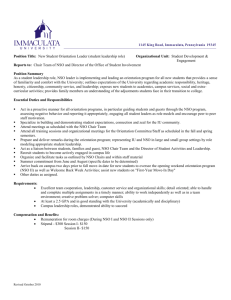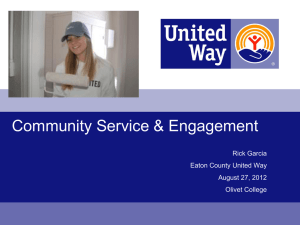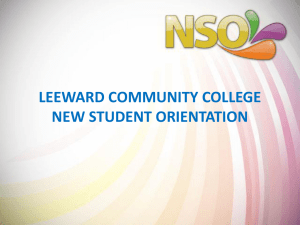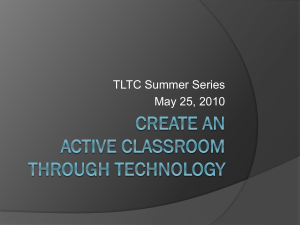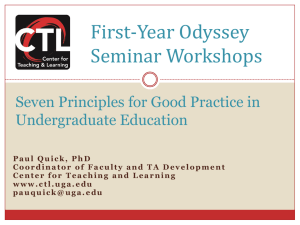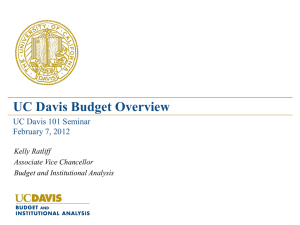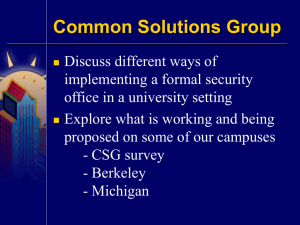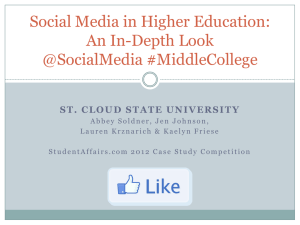Social Media comes to New Student Orientation
advertisement
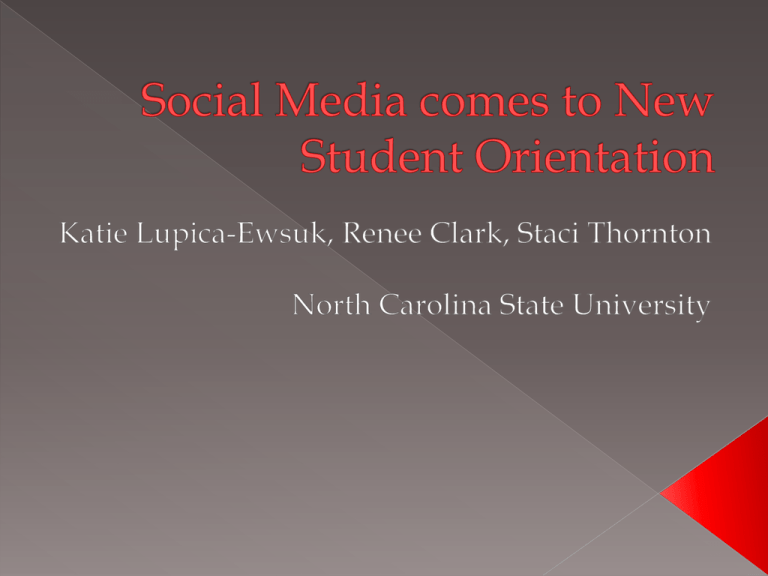
New Student Orientation (NSO) plans to use social media to connect with incoming students and provide them a forum to ask questions and gather useful information before stepping on campus. A strategic plan has been developed to appropriately implement the social media platforms based on Barr and Keating (1985) model. McClellan and Stringer (2009) identified the strategic plan model developed by Barr and Keating (1985) as a model that works well with student affairs programming. Barr and Keating (1985) introduced three essential elements in planning and complementing any program: › The context › The goal › The plan “The goal of almost any social media campaign should ultimately be to push people to the college’s website for more detailed information and action” (Halligan, 2010, p. 32) In the initial assessment of our strategic plan, we have examined the context and determined what resources are needed. Context: University Culture New Student Orientation’s Mission New Student Orientation’s Learning Objectives Benefits of Proposed Social Media Plan Resources: Interested Constituencies Required Human Resources Required Fiscal Resources Timing of the Development and Implementation of Plan NC State is a large research university located in a metropolitan area in the southern United States. NC State has population of 34,000 students and all incoming undergraduates and transfer students (about 6,300) can gather information and participate in orientation activities through the New Student Orientation (NC State). Activities include: › 17 overnight sessions for first-year students › 2 one day sessions for transfer students › 3 one day sessions for both first-year and transfer students. › In addition supplemental programming is offered to continually help students with their transition to NC State (NC State). “New Student Orientation coordinates NC State University's collective efforts to provide programs and services to newly admitted first year and transfer undergraduate students that will facilitate their transition into NC State, prepare them for the institution's educational opportunities, and initiate their integration into the institution's intellectual, cultural, and social climate” (NC State) Check Out www.ncsu.edu/nso/ Orientation is now considered a comprehensive process rather than a small program (Council, 2009). CAS encourages orientation programs to not merely adjust to changes in student population but to develop “new and creative programs and methodologies” in order to meet the needs of new and transfer students (Council, 2009, p. 322) Help transition students to the college experience Communicate with students using a medium they may be familiar with and use regularly Provide students information to make orientation more valuable and meaningful Give students a platform to ask questions and interact with other incoming students Support an environment that incoming student can connect with on-campus students “Introduces students to information and resources that prepare them for their first semester at NC State” (NC State). › Social Media can be used to enhance students understanding of information and resources presented at orientation through having a place to ask questions, watch informational videos, and read and respond to current student blogs. NSO “is a service department, responsible for coordinating the collective efforts of the university to introduce students to the institution’s intellectual, cultural, and social climate, and in particular the academic environment and expectations of each college at NC State” (NC State). › Current students from a variety of backgrounds will help monitor and provide up-to-date information on the social media sites. › Students will be able to answer questions about classes, things to do on campus, and other campus related information. “Provides time-appropriate messages to students, understanding the importance of delivering messages to students when they are most likely to be heard and impact behavior” (NC State). › Incoming students use social media outlets several times a day. Many have access to social media on their cell phones. › Using social media to pass on information will allow NC State to reach a vast number of students who may not have access to their university email yet. “Organizes programs that serve as one of the first of many steps in transitioning students to their new environment, recognizing the importance of additional complementary programs and services provided by academic and student support units of the university” (NC State). › Social Media can be a place to direct students to other resources and information around campus organizations and college departments. › It can also be a place to advertise programs. Current incoming students are from the Millennial generation and they were born between 1982 and 2000. These students will continue to flood campuses for the next several years. As we explored our target population, we have identified the social media outlets (i.e., Facebook and Twitter), Millennials use to engage in two-way technology. They do not simply view a website; they want to be able to interact (Lindbeck & Fodrey, 2010). Millennials are the first generation to grow up using Facebook and tweeting as an everyday occurrence, as opposed to viewing them as new technology. Many studies in the past have focused on the difference between Generation X and Baby Boomers so that they can better understand each other in the workplace; similar studies are now being conducted to show how best to understand Millennials (Smola & Sutton, 2002). Technology has been a huge part of the Millennials’ every day life and colleges and universities need to be able to keep up with this trend (Thielfoldt & Scheef, 2004). Lindbeck and Fodrey (2010) describe Millennials as having a “constant need to be connected to their social pipelines, have access to digital information and collaborate with their peers” and that they are “ready to have its voice heard, share its ideas and lead by actions” (p. 11). A recent survey discovered that 88% of prospective students would seriously think about not attending a college based on their website (Lindbeck & Fodrey, 2010). Millennial students tend to focus only on information directly related to them and they often do not reconsider information that did not appear relevant the first time (Lindbeck & Fodrey, 2010). Social media outlets are already being explored in higher education institutions. › A survey done by the Babson Survey Research Group of 1,000 faculty members showed that 30% of them use social media to connect with their students (Blankenship, 2011). › Colleges and universities need to get on board with social media because it is not going away (Blankenship, 2011). Using social media in college leads to successful integration into the work place and encourages active citizenship. › Having a blog and putting that on your resume shows your employer that you are engaged member of society (Blankenship, 2011). › To prepare incoming students, orientation should show them how social media can and will be used throughout their college careers. Not only will using social media prepare students for college, social media is being used in interviews for jobs as well (Blankeship, 2011). Campus is always looking for ways to reduce the use of paper products. By using social media as an outlet for information, less extensive mailings will be required Pull information from all campus departments Method of mass communication to all students at minimal cost to the University Keep competitive with schools already utilizing such tools With the undergraduate population growing, NC State needs to look at new ways to recruit and retain students (Lindbeck & Fodrey, 2010). Astin’s Involvement (Engagement) Theory › Theory Summary College outcomes are viewed as functions of three sets of elements; inputs, environment, and outcomes. Theory explains the dynamics of how students change or develop. (Astin, 1984 Defining of Elements Inputs - demographics, student background, previous experiences Environment- range of experiences encountered during college Outcomes - characteristics, knowledge, attitudes, beliefs, values, etc. that exist after colleges Theory has been the foundation for the study of student involvement and engagement. As involvement has now been considered engagement, it represents the time and effort students devote to activities that are empirically linked to desired outcomes of college and what institutions do to induce students to participate in these activities (Kuh, 2009). Theory of Involvement - Element Application Inputs The demographic, student background, and experiences show a knowledge of social media tools. As such, there is a precedent of familiarity and engagement already with Facebook, Twitter, and other outlets. Environment Colleges and universities across the country have adopted the use of such tools and have engaged students through internet tools in their recruitment and application processes. Furthermore, the University has embraced and changed how they function to show an importance of online communication. The University continues to enhance its technology environment to support such interactions. Outcomes If the University continues to meet students where they are, in this case with a current knowledge and use of social media tools, we can expect them to continue to use such tools during and after their matriculation to stay connected to the University. The more we utilize an environment that students are familiar the easier to disseminate information and receive their immediate feedback. Chickering and Gamson’s Seven Principles › In the March 1987 AAHE Bulletin, Chickering and Gamson presented the Seven Good Principles for Good Practice in Undergraduate Education (Chickering & Gamson, 1987). › Purpose was to focus on improving the teaching and learning of students. The principles established were: 1. Encourages contact between students and faculty 2. Develops reciprocity and cooperation among students 3. Encourages active learning 4. Gives prompt feedback 5. Emphasizes time on task 6. Communicates high expectations 7. Respect Diverse talents and ways of learning › › An environment must created among faculty, staff, students, administrators, and external groups that can support these principles as well as the respective desired outcomes of the education of the particular institution. In 1996, the principles were revisited by Chickering and Ehrmann to leverage the use of technology against application of the principles, which suggests that the higher education understands the importance of using technology to improve learning and teaching in the environment. Seven Principles Application Faculty/Student Contact The utilization of social media outlets will allow for the dissemination of information to students as it relates to academic advising, transitional support, and other important “to-dos” to prepare for the transition to a college student. Develop Reciprocity and Cooperation Students have a created avenue to communicate with faculty, staff, and administration. This developed platform for communication will allow for students to act upon items sent from the university and vice-versa. Active Learning The use of new tools calls for active learning. Faculty, staff, and administrators will be learning new technologies and this offers the opportunity to learn from students that are most familiar with the technologies. The sides will also be able to consider methods to enhance how the University utilizes such tools. Prompt Feedback The ability to send inquiries to a mass audience and solicit responses in the form of blogs or the media outlet used, will allow the University to gain real time and truthful feedback to better the student experience and allow students to feel engaged in decision making processes. Emphasize Time on Task As technology presents a faster mode of communication, time is freed to commit to other tasks. Communicate High Expectations In new student orientation, we will be able to communicate the expectations of our students during their transition as well as when they arrive on campus. They will have a plethora of mediums to obtain these expectations real-time and appropriately respond as to how they have met them (i.e. residence hall registration, summer reading, etc.) Respect Diverse Talents and Ways of Learning By offering social media outlets as a medium for communication, we are openly respecting the diverse ways of obtaining knowledge that our future/current students require. This program would serve new students and transfer students along with any department or organization on campus that wanted to provide information for the social media sites. For Example: University Housing, Carmichael Complex, Student Health Center, Multicultural Center, Alumni Association The NC State Alumni Association already has an established Facebook account; so by engaging students in social media as freshmen, through the NSO Social Media Plan, they will learn to expect it and NC State can continue the usage as they become alumni (Halligan, 2010). Goal Statement: NSO hopes that using social media will build students' confidence in involving themselves in campus activities that they find out through such sites. It has been observed that current students and incoming students use social media to gather information and engage in community forums. Human: A graduate student to oversee and create all social media sites. Student volunteers to answer questions and keep “Life at NC State” blogs. Fiscal: Graduate student stipend, a computer, initial mailings, and advertising of the new program Timing: March/February to ensure all policies and procedures are in place With an approved plan, new policies, procedures, and job descriptions will be created. Hire a graduate assistant (GA) in February at the Higher Education Administration Recruitment Weekend Begin training of GA on June 1 Train student interns by June 15 Make space in NSO office Hire a GA and pay them a stipend Purchase a laptop for the GA’s use while they are employed by NSO NSO’s original marketing materials will be edited to include the new social media site information Create new marketing materials, including postcards for the program Create t-shirts advertising the program for Orientation staff and as giveaways that will say “Follow Us” and “Be Our Friend” Social media has the opportunity to save colleges money; once they are established, mailing and newsletters can be sent electronically (Halligan, 2010). This will save on postage and labor fees when printing and stuffing envelopes (Halligan, 2010). Proposed Budget: Laptop Computer = $700.00 Graduate Student stipend = $12,000 Postcards – printed & mailed = $1,250.00 T-Shirts = $500.00 Miscellaneous = $550.00 Total = $15,000 Protecting the privacy of students and the University Controlling the social media environment Targeting nontraditional students Creating a policy about the appropriateness of messages and information posted Since Facebook and Twitter are external sites, policy needs to be developed on how to handle information learned on these sites. Students may not want their schools involved in what they see as their social avenue. A balance between social media usage and appropriateness is necessary (Lindbeck & Fodrey, 2010). The implementation of this program will begin in the Spring of 2011 and while assessment can begin at the end of the year, the program should be maintained a minimum of two years to achieve valuable feedback. Organization Chart As recommended by the CAS Standards, selfevaluation will take place following orientation events. Questions will be added to the NSO evaluation to not only get feedback from staff members but students as well. These internal and external evaluations of expectations must measure “to what degree the stated mission, goals, and student learning and development outcomes are being met” (Council, 2009, p. 329). Results will be used to enhance the program. Astin A. (1984). Student involvement: A developmental theory for higher education. Journal of College Student Personnel, 25, 297–308. Blankenship, M. (2011). How social media can and should impact higher education. The Hispanic Outlook in Higher Education, 21(7), 40-41. Chickering, A.W. &Gamson, Z.F.(1987). Seven principles for good practice in undergraduate education. AAHE Bulletin, 3–7. Chickering, A. & Ehrmann, S.C. (1996). Implementing the Seven Principles: Technology as Lever. AAHE Bulletin, 3-6. Council for the Advancement of Standards in Higher Education. (2009). CAS professional standards for higher education (7th ed.). Washington, DC: Author. Halligan, T. (2010). The social media evolution: Online tools drive opportunities for alumni outreach, fundraising. Community College Journal, 80(4), 30-33. Junco, R., Heiberger, G., & Loken, E. (2010). The effect of Twitter on college student engagement and grades. Journal of Computer Assisted Learning. doi:10.1111/j.1365-2729.2010.00387.x Keeter, S. & Taylor, T. (2009, December 11). The Millennials. Retrieved from http://pewresearch.org/pubs/1437/millennials-profile Kuh, G.D. (2009). What student affairs professionals need to know about student engagement. Journal of College Student Development, 50, 683–706. Lindbeck, R. & Fodrey, B. (2010). Using technology in undergraduate admission: A student perspective. Journal of College Admission, 1117. McClellan, G. S., & Stringer, J. (2009). The handbook of student affairs administration (3rd ed.). San Francisco: Jossey-Bass Smola, K.W. & Sutton, C.D. (2002). Generational differences: Revisiting generational work values for the new millennium. Journal of Organizational Behavior, 23, 363-382. Thielfoldt, D. & Scheef, D. (2004, August). Generation X and the millennials: What you need to know about mentoring the new generations. Retrieved from http://apps.americanbar.org/lpm/lpt/articles/mgt08044.html Young, J.R. (2010). How social networking helps teaching (and worries some professors). The Chronicle of Higher Education. Retrieved from http://chronicle.com/article/How-Social-Networking-Helps/123654/
